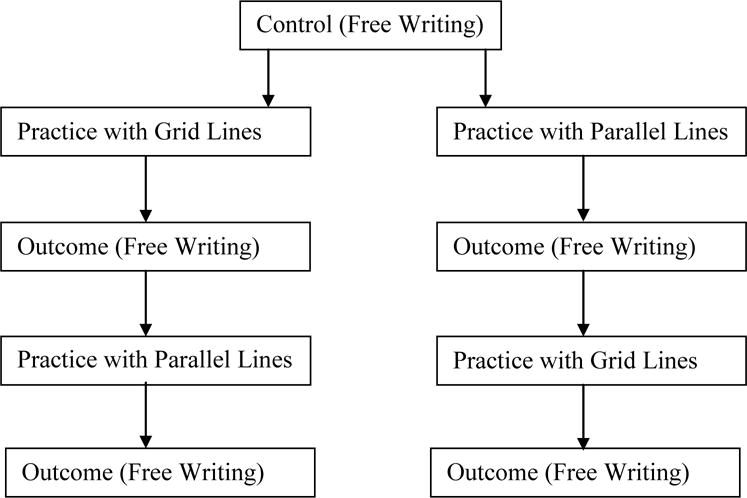Abstract
Objective
This pilot study was designed to compare a change in micrographia between using grid lines and parallel horizontal lines as visual cues in individuals with Parkinson’s disease.
Design
Single group pre- and post-test.
Setting
Research lab.
Participants
Eleven males with Parkinson’s disease.
Interventions
Practice writing words with parallel and grid lines. The sequence of practicing was randomized.
Main outcome measures
Length of words.
Results
The length of the words after practicing with parallel lines was longer than in the initial free writing condition (17.83 ± 3.93 cm vs. 23.36 ± 5.82 cm, p = .008). The length of the words after practicing with grid lines was also longer than during free writing (17.83 ± 3.93 cm vs. 22.65 ± 4.04 cm, p=.003). The length of the words after practicing with parallel lines was not different from that after practicing with grid lines.
Conclusion
Improvement in letter size after practicing with horizontal parallel lines and grid lines were not different. The addition of vertical lines to form a grid did not appear to improve the writing more than horizontal lines alone in persons with Parkinson’s disease who experienced micrographia.
Keywords: Parkinson’s disease, rehabilitation, micrographia, visual cue
Introduction
Persons with Parkinson’s disease often show reductions in writing size as the length of the text they produce increases. This sign is called micrographia. Micrographia is one of the characteristic clinical signs of Parkinson’s disease. It is a common and often early sign of Parkinson’s disease. Approximately 75% of patients with Parkinson’s disease experienced micrographia.1 Only a few studies have reported interventions to improve micrographia. Oliveira et al. studied the effect of providing visual targets and the effect of verbal commands on micrographia in persons with Parkinson’s disease.2 Patients wrote with more normal amplitude when given either the visual or auditory cue. They also found a short-term effect, which was demonstrated by improvement in writing, which persisted for a short time after the withdrawal of cues.
In a study by Teulings and colleagues, visual feedback provided by a computerized display digitizer was used to control handwriting size in patients with Parkinson’s disease.3 The patients wrote sequences of eight cursive letter “l” loops with visual target sizes on a flat panel display digitizer, which both recorded and displayed the pen movements. The results showed that patients with Parkinson’s disease rely on the visual feedback of previous or ongoing strokes to program subsequent strokes.
Letter size is composed of two dimensions; one is amplitude, the other is width. Parallel lines have been reported to improve the amplitude of letters.1,2,3 In order to increase the size of letters, both the amplitude and the width need to be improved. To our knowledge, there has been no study reported in the literature using vertical lines as visual cues to improve the width of letter size in persons with Parkinson’s disease.
The main purpose of this study was to assess whether using grid lines (both horizontal and vertical) as a visual cue had a more positive effect on letter size than using parallel horizontal lines alone in individuals with Parkinson’s disease.
Methods
Eleven persons with Parkinson’s disease were recruited from the XXX. All participants experienced micrographia, which was identified by item 8 (Handwriting) of the Unified Parkinson’s Disease Rating Scale (UPDRS), with a score of 1 (slightly slow or small) or higher.4 None of the subjects had a history of cognitive impairment and all were able to write in English. All participants preferred writing with the right hand. Each subject received an explanation of all procedures and read and signed an approved consent form. A brief medical history, demographic information, disease stage and disease duration were obtained from the subjects’ reports and/or their electronic medical records.
This pilot study used a within-subjects design to compare two writing conditions: 1) writing immediately after practicing with parallel lines, and 2) writing immediately after practicing with grid lines. Free writing (writing without lines) was used as a control. The sequence of the experiment is displayed in a flow diagram (Figure I). The sequence of practicing with either parallel lines or grid lines was randomized. Six subject practiced with parallel lines first, and five subjects practiced with grid lines first. Subjects were their own controls and performed the writing task while on their usual anti-parkinsonian medications.
Figure I.

A Flow Diagram of the Writing Sequence
For the free writing condition (control), the subjects were asked to write three words (Monday, Tuesday, Wednesday) in their usual size on a blank, white 80 × 21.5 cm sheet of paper. For the parallel lines condition, they were asked to practice writing the three words on a white sheet of paper with parallel lines (10 mm apart). This distance is slightly greater than the distance between lines on the most common ruled pads of paper. The instruction was, “Try to touch each letter on the top and bottom lines.” After practicing 5 times and resting for one minute, they were asked to write the three words again on a white, blank, unlined sheet of paper for the outcome measurement. For the grid lines condition, they were asked to practice writing the three words on a sheet of paper with grid lines (10 mm × 10 mm) 5 times. The instruction was, “Try to touch each letter on the upper, lower, left and right lines.” After resting for one minute they were asked to write the three words on a white, blank unlined sheet of paper. No additional verbal reminder was given after the subjects started writing. Five-minute rest periods were given between writing conditions to avoid muscular fatigue. Each participant used the same ballpoint pen for the entire experiment. At the end of the session, subjects were asked to complete a brief questionnaire regarding their views of the effect of parallel and grid lines on their writing.
PlanWheel XLU (PlanWheel, Scalex Corporation, Carlsbad, CA) is a tool with a small wheel to measure distance on blueprints and maps. The distance is displayed instantly and continuously while the wheel is being rolled. The PlanWheel XLU is able to measure distance in feet, inches, and centimeters. In this study, the PlanWheel XLU was used to measure the length of the words in centimeters. Length of writing was previously used as an outcome in a micrographia study by other investigators.5 To improve the accuracy of measurement, the three sets of writing for each subject were enlarged using a copying machine set at 200%. Then, the length of the three words was measured using the PlanWheel XLU and added together for data analysis.
Statistical Analyses
All analyses were done with SPSS version 17.0. Demographic data of patients including gender, age, disease duration, disability stage, type of assistive device, and UPDRS scores were descriptively summarized. One-way repeated-measures analysis of variance (ANOVA) was used to assess the effects of line provision on the length of the writing sample. Post-hoc comparisons with Bonferroni adjustment were performed to compare the length of the writing samples between each pair of the three conditions. These comparisons were to determine which, if either, type of line helped more. Responses from the questionnaire were summarized to describe the perspectives of the subjects regarding the influence of the lines on their writing.
Results
Our sample consisted of 11 males with Parkinson’s disease. The average age of the subjects was 72.20 ± 8.16 years, and the average number of years since diagnosis of the disease was 5.35 ± 3.11. The average of Hoehn and Yahr staging for Parkinson’s disease was 2.55 ± 0.50.6 The average score on the motor section of the UPDRS was 31.20 ± 8.13. Average height and weight were 176.91 ± 10.47 cm and 83.86 ± 13.72 kg, respectively.
Examples of writing in the three conditions are provided in Table 1. In the initial free-writing control condition, the mean length of the total of the 3 words after they were enlarged was 17.83 ± 3.93 centimeters, in the parallel lines condition it was 23.36 ± 5.82 centimeters, and in the grid lines condition it was 22.65 ± 4.04 centimeters. The one-way repeated-measures ANOVA revealed a significant difference in the length of words among the three conditions (F = 10.8, p = .009). The results of the post-hoc, pair-wise comparisons with Bonferroni adjustment indicated that the length of the words after practicing with both parallel (p = .008) and grid lines (p = .003) were longer than in the initial free writing condition. However, the length of the words after practicing with grid lines was not significantly different from the length after practicing with parallel lines. Sixty-three percent of the participants reported that parallel lines helped their writing, whereas only 18 percent reported that grid lines helped with their writing. More participants felt that they would use parallel lines rather than grid lines, if they had lined paper. One person would not use either kind of lined paper (Table 2). Although some participants reported some improvement in writing after practicing with the grid lines, they also noted that it took more effort to write when following the instructions for using the grid lines.
Table 1.
Examples of writing in three conditions.

|
Initial free writing (control) |

|
After practice with parallel lines |

|
After practice with grid lines |
Table 2.
Self-Report Questionnaire (N=11)
| Questions | Number of Responses | |
|---|---|---|
|
| ||
| Which type of line, if either, helped your writing the most? | ||
| - Parallel lines | 7 | |
| - Grid Lines | 2 | |
| - Neither helped | 0 | |
| - Both helped equally | 2 | |
|
| ||
| Do you think you would use paper with either type of line when you write, if you had some? | YESa | NO |
| - Parallel lines | 10 | 0 |
| - Grid Lines | 7 | 2 |
| - Neither | 1 | 1 |
|
| ||
| What did you like about: | ||
| - Parallel lines | Keep letters straight, Lines equally spaced reinforce the hand to keep letters the same size, Letters don’t get smaller, Easy to follow | |
| - Grid Lines | Keep letters same size, Make letters more equal in size and dimension but use more effort when writing with grid lines, Too tired to keep up with, Make letters bigger, Need more effort to write, Did not like writing with blocks. | |
|
| ||
| Other Comments: | It is easier to follow parallel lines. Parallel lines helped better than grid lines. | |
Some subjects selected more than one type of line.
Discussion
Our results demonstrated that the length of words was longer after practicing with either parallel or grid lines. Grid lines provide four visual cues (top, bottom, left and right) whereas parallel lines provide only two visual cues (top and bottom). We hypothesized that four cues would improve letter size more than providing only two cues. This hypothesis was not supported by the results. Adding two more cues for the writing task may require too much mental effort or attention for persons with Parkinson’s disease, as implied by some of the comments made by participants on the questionnaire (Table 3). However, this potential explanation should be investigated in future studies.
Micrographia is one of the common characteristic features in persons with Parkinson’s disease. This small handwriting problem is caused by hypokinesia, a reduction in movement amplitude.1 Levodopa has been found to partially improve micrographia.7 Subthalamic nucleus deep brain stimulation and pallidotomy have improved writing speed more than letter size.8,9 Previous studies reported that providing external cues such as auditory or verbal reminders such as, “Write big.” 2, 3 and visual targets such as dots or horizontal lines improved letter size.2,7
Writing is an automatic skill, which means a normal person performs the task without conscious thought or deliberation about the amplitude of the movement. Persons with Parkinson’s disease have lost this automatic skill and fail to achieve normal amplitude.2 Similar to previous studies, our results showed than providing parallel lines improved letter size in persons with Parkinson’s disease.2,7 Visual cues specified the desired amplitude of the movement and encouraged the person to pay attention to the writing task.
There are a number of limitations of the study, which must be addressed. First, the sample size was small, with only 11 males with Parkinson’s disease. However, the effect of practicing with lines was large. Letter size length increased approximately 31% after practicing with the parallel lines, and 27% after practicing with the grid lines. We did not intentionally recruit only men for the study. Due to the nature of the veteran patient population, there were far more male patients than female patients attending the Parkinson’s disease clinic during the study and they happened to be the ones who agreed to participate. In future studies, women should also be included. Second, the subjects performed the free writing first as a control, followed by the randomized sequence of the two writing conditions with lines. The partial cross-over design might create a likelihood of cumulative practice effect. This effect was minimized to some extent because approximately half of the subjects practiced with parallel lines first and the other half practiced with grid lines first. Five-minute rest periods were also provided between conditions to minimize this effect. Third, the assessor was not blinded as to the condition being measured, which might have introduced a confounding bias. Fourth, a distance of 10 mm and the instruction given to write with visual lines might be impractical in daily writing because the space allowed on many forms may be pre-formatted to a different size and the instructions to touch each letter to the lines does not take into account the fact that lower case letters are smaller than upper case ones and some letters go above or below the usual space, such as lower case letters b or p. Fifth, the study did not address the size of writing longer text passages such as one might produce in a letter. Sixth, longer writing samples should be included in future studies to determine whether the effect of practicing with lined paper generalizes to writing more than a few words. Finally, we only demonstrated the immediate effect of lines on writing performance. Future studies should assess the duration of the effect.
In conclusion, this pilot result showed improvement in letter size after practicing with horizontal parallel lines and with grid lines. However, the addition of vertical lines to form a grid did not increase letter size compared with horizontal lines alone.
Clinical messages.
Simple parallel horizontal lines improved handwriting in persons with Parkinson’s disease who have a problem with micrographia.
The addition of vertical lines to form a grid did not further improve the size of writing.
Compared with parallel horizontal lines; grid lines may actually make the task more difficult if the person attempts to make the letters touch all 4 sides of the cell of the grid.
References
- 1.Jarzebska E. Evaluation of effectiveness of the micrographia’s therapy in Parkinson’s disease patients. Pol Merkur Lekarski. 2006;20(120):688–90. [PubMed] [Google Scholar]
- 2.Oliveira RM, Gurd JM, Nixon P, Marshall JC, Passingham RE. Micrographia in Parkinson’s disease: the effect of providing external cues. J Neurol Neurosurg Psychiatry. 1997 Oct;63(4):429–33. doi: 10.1136/jnnp.63.4.429. [DOI] [PMC free article] [PubMed] [Google Scholar]
- 3.Teulings HL, Contreras-Vidal JL, Stelmach GE, Adler CH. Adaptation of handwriting size under distorted visual feedback in patients with Parkinson’s disease and elderly and young controls. J Neurol Neurosurg Psychiatry. 2002;72(3):315. doi: 10.1136/jnnp.72.3.315. [DOI] [PMC free article] [PubMed] [Google Scholar]
- 4.Fahn S, Elton RL, members of the UPDRS Development Committee . Unified Parkinson’s Disease Rating Scale. In: Fahn S, Marsden CD, Calne DB, Goldstein M, editors. Recent developments in Parkinson’s disease. Vol. 2. Florham Park, NJ: Macmillan Health Care Information; 1987. pp. 153–64. [Google Scholar]
- 5.Ondo WG, Satija P. Withdrawal of visual feedback improves micrographia in Parkinson’s disease. Mov Disord. 2007 Oct 31;22(14):2130–1. doi: 10.1002/mds.21733. [DOI] [PubMed] [Google Scholar]
- 6.Hoehn M, Yahr MD. Parkinsonism: onset, progression, and mortality. Neurology. 1967;17:427–442. doi: 10.1212/wnl.17.5.427. [DOI] [PubMed] [Google Scholar]
- 7.McLennan JE, Nakano K, Tyler HR, Schwab RS. Micrographia in Parkinson’s disease. J Neurol Sci. 1972 Feb;15(2):141–52. doi: 10.1016/0022-510x(72)90002-0. [DOI] [PubMed] [Google Scholar]
- 8.Siebner HR, Ceballos-Baumann A, Standhardt H, Auer C, Conrad B, Alesch F. Changes in handwriting resulting from bilateral high-frequency stimulation of the subthalamic nucleus in Parkinson’s disease. Mov Disord. 1999 Nov;14(6):964–71. doi: 10.1002/1531-8257(199911)14:6<964::aid-mds1009>3.0.co;2-c. [DOI] [PubMed] [Google Scholar]
- 9.Balás I, Llumiguano C, Dóczi TP. Ablative stereotactic surgery improves manual performance time in Parkinson’s disease. Parkinsonism Relat Disord. 2006 May;12(4):223–7. doi: 10.1016/j.parkreldis.2005.11.010. [DOI] [PubMed] [Google Scholar]


